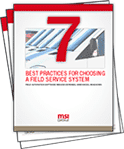Running a profitable field service organization can be difficult, so don’t overlook easy opportunities to cut costs and grow revenue.
Imagine you’re in high school, sitting in a classroom, listening to your teacher lecture. As your eyes start to glaze over because you have heard the same information at least 10 times, you make an executive decision to refocus and take notes. You know that any information the teacher feels is worth repeating is important and will definitely be on the test.
The same concept can be applied to your field service organization. We know you’ve heard it before, but knowing how to cut costs and grow revenue are two important lessons that will certainly “be on the test.” With that being said, consider this an ultimate study guide to getting an A+ in profitability.
Follow along as we uncover 10 easy solutions to gaining profitability with the right technology:
1.Eliminate Paper with a Mobile Field Service App
Switching to a mobile solution completely eliminates your organization’s need for paper. While it might seem like a small cost savings, using paper for everything adds up. Eliminating paper is also a time-based cost savings. In other words, it allows your workers to repurpose their time by doing something more productive. Spending time filling out work order forms is time that techs aren’t working, meaning it’s unbillable. Cutting unproductive time with mobile leaves more time for your technicians to complete billable tasks.
2.Save Gas with Better Scheduling and Telematics
While you can’t control the rise and fall of gas prices, you can control your field techs’ schedules. The ability to locate your technicians via a visual scheduler using GPS will allow you to more efficiently schedule work orders, which will reduce unneeded driving and gas consumption.
For example, say that one of your technicians is scheduled to complete a job at Point A on Monday, but is scheduled to complete a job at the same location on Friday. With a visual scheduler, you would see the senselessness of his current schedule, and reschedule both jobs on the same day to reduce drive time.
Other advantages to using a visual scheduler include the ability to locate and schedule the technicians closest to a job site and scheduling a technician based on who has the needed tools in his van.
3.Eliminate Duplicate Data Entry with ERP Integration
By adopting a mobile solution with ERP integration, your back office will no longer have to reenter information that your field techs have already recorded. In other words, all of your systems are linked.
For example, a field tech can record all the billing information he needs on his mobile device, which will automatically integrate with the accounting system. This means your back office isn’t left entering the same information into the computer a second time and they can use the extra time on other projects.
4.Improve Inventory Tracking and Reduce Waste with Mobile & Integration
Keeping an accurate account of your inventory is important because it lets you know what inventory your company has purchased, where it is, and if it was sold.
By tacking inventory, you don’t eat the cost of lost or unused parts. Keeping track of your inventory via a mobile solution provides your field techs with an accurate account of company inventory at their fingertips. This means that techs can ensure customers were billed for things such as specialty products and also return any products that went unused.
5.Reduce Phone Calls with Schedule Board Alerts Engine
Implementing a mobile solution with a schedule board alerts system means that your field tech’s job status is automatically updated. With this information, your schedulers can see if one technician is ahead of schedule, and if he is, schedule him to another job.
A schedule alerts board gives you the ability to move people around based on who is running late, and speed processes so your technicians can work more efficiently. A benefit of scheduling alerts is that it is all done “behind the scenes,” so to speak. There is no need for constant phone calls with status updates, because alerts are sent to the schedule board with every status change.
6.Grow Revenue with Better Contract Renewals
As a field service organization, your business relies on your customer contracts. In order to make sure your contracts are renewed, it’s important to know when they are about to expire. For example, by employing service management software in your organization, you can send and receive alerts when a customer’s contract is about to expire.
7.Improve Warranty Claims with Asset Tracking
There are few situations messier than warranty claims, especially when you don’t have the documentation to prove or disprove a claim. Having a system that keeps an accurate account of each of your customers’ warranties allows you to get paid for the work your field techs perform.
For example, if one of your field techs fixes a generator that the customer claims to be under warranty, that field tech is able to see on his mobile device that, in fact, the warranty expired three months prior and the customer will have to pay for his labor.
8.Streamline Operations and Improve First Time Fix Rates with Portals and Reporting
In order to better your company, you need to have a good handle on where you are today, meaning you need to develop of form of measuring performance data and statistics. Implementing a mobile solution that involves portals allows your organization to measure its success, specifically first time fix rates.
Having the ability to view your company’s first time fix rates through portals and graphs allows you to better detect where issues stem from, and adjust your strategies accordingly. Better monitoring of your customer’s first time fix rate will also help you become more SLA compliant.
9.Improve Customer Satisfaction with Customized Inspections
Have your field techs ever been asked a question along the lines of: “It really took 7 hours to fix this?” or, “You had to buy all these parts?” Discrepancies between your customers and the billing statements your techs create can cause problems with customer satisfaction; however, by adopting a uniform mobile inspection solution, some of these discrepancies can be resolved.
For example, field techs can use their smartphones to take pictures of broken parts and attach them to a safety check, giving your customers a better understanding of what they are paying for. This makes for a strong face-to- face customer experience by presenting them with a completed expectation they can view and sign off on. Remember, happy customers are repeat customers, and repeat customers lead to referrals.
10.Reduce Time to Invoice with Online Mobile
It takes a lot of time for your field techs to manually write all of your customers’ work order forms. Writing work orders on a sheet of paper also requires that they travel to the back office in order for the work orders to be recorded.
Having a mobile solution ensures that your back office isn’t bogged down with hours of paperwork and that invoices are produced quicker. Mobile also eliminates the possibility of lost work orders and your back office’s inability to decipher illegible handwriting.
Test Day: Prove Your Cost-Saving Readiness
Now that we’ve spent some time reviewing, you’re ready to take the test. We know we’ve given you a lot of information, but don’t panic. Remember, you have heard this all before, and you are well prepared. So be confident, and start leading your organization toward a more profitable future.

7 Best Practices for Choosing a New Field Service App
Take steps to grow your company with a field service management app. Use these tried and true methods for organizing the field service software buying process. Eliminate the unexpected and increase your chances of success with your software in the new year.
Like this post?
Subscribe to our Field Service Management Blog for original weekly content updates.










